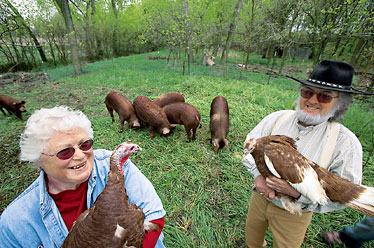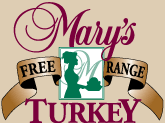|
Monday, Jun. 06, 2005
Eat Them Or Lose Them
Food lovers are developing a taste for
"heritage" breeds ignored by big farms and nearly extinct
By
MARGOT ROOSEVELT

JOEL SARTORE FOR TIME
RESTOCKED: The Sorells are bringing
back Bourbon Red turkeys and Red Wattle pigs
Down a dirt road, amid rolling hills
of alfalfa, Larry and Madonna Sorell's 40-acre spread looks, smells
and sounds like any other Kansas homestead. The
weathered wooden farmhouse. The whiff of manure. The cacophony of
grunting, gobbling and bleating. But the livestock at Lazy S Farms
are no ordinary farm animals. Rooting about in the fields are Red
Wattle pigs, a breed thought to have been imported from New
Caledonia in the 1700s and practically extinct until a wild herd
surfaced in Texas. The turkeys are Standard American Bronzes, which
were Thanksgiving fare for more than a century but have now been
reduced to some 950 breeder birds. The lambs are Katahdins, a
subspecies developed in Maine and named for the state's highest
peak.
Fifty years ago, such breeds were
common on family farms. But with the intensive post--World War II
industrialization of American agriculture, they all but died out,
surviving only on isolated farmsteads for local consumption. In the
past five years, however, a new market has sprung up for now rare
varieties, thanks to a lively network of big-name chefs,
conservation-minded farmers and slow-food devotees. Like heirloom
tomatoes and antique roses, so-called heritage meats are attracting
discriminating customers--and fetching top dollar.
For Larry Sorell, 65, a
fourth-generation grain planter, raising rare animals began as a
lark. But as he learned more about the threat to the survival of
traditional varieties, he came to see his hobby as a higher calling.
"If a breed goes extinct, all the genetics go down the tube," he
says. Besides, he adds as he waters a passel of squealing piglets,
"I just love to watch 'em grow."
Sorell's pigs aren't the only things
that are growing. Heritage Foods USA, the largest mail-order firm in
the business, was buying five 200-lb. hogs a month from Lazy S but
is ratcheting up to 25 a month to meet demand. Besides Red Wattles,
named for their ruddy hair and folds of neck skin, the company's
biannual "almanac" offers 70 products, from
Tunis lamb
to Bourbon Red turkeys. "Dozens of delicious American treasures with
a long history are on the brink of extinction," says Patrick
Martins, co-founder of the company. "We must eat them to save them."
The renewed interest in rare breeds
is driven in part by the limited offerings of factory farms in the
U.S. Agribusinesses, trying to maximize efficiency in a competitive
market, pursue a ruthless genetic specialization, driving the
industry toward what ecologists call monocultures--vast numbers of a
single variety. According to the American Livestock Breeds
Conservancy (ALBC), 15 different breeds of pigs were raised for
market in the 1930s; today, six of them are extinct. Only three
varieties--Hampshire, Yorkshire and Duroc--account for
75% of U.S. production. In the 1920s, some 60 breeds of chickens
thrived on American farms; today one hybrid, the Cornish Rock cross,
supplies nearly every supermarket. A single turkey dominates: the
Broad Breasted White, a fast-growing commercial creation with such a
huge breast and short legs that it is unable to mate naturally.
Mass marketing may demand a cow that
produces more milk or a duck with a bigger breast. But narrowing the
genetics means losing valuable traits, such as resistance to disease
and drought, intelligence, easy birthing and longevity. Alarmed at
the trend, the U.S. Department of Agriculture is creating a national
gene bank in Fort Collins, Colo., for endangered
livestock. The urgency has grown since 9/11. "A virus introduced
into a poultry plant with 10,000 birds of a single variety is a
potent terrorist opportunity," says ALBC executive director Charles
Bassett.
But what fires up many old-breed
farmers--and draws food lovers from New York to
California--is how the heritage meat tastes. Chefs rave about the
complex, succulent flavors of Tamworth pork and Katahdin lamb.
Martha Stewart has featured a Standard American Bronze on her
Thanksgiving cooking show. At Muss & Turner's in suburban Atlanta,
chef Todd Mussman puts Lazy S Farm's lean, dark Red Wattle ham on
sandwiches that sell for $11.99 each. "The texture is so silky, it
melts on the tongue," says Mussman. He tells customers they are
saving not just endangered breeds but small farmers too. Says
Mussman: "People want to feel good about what they eat."
And there's a lot to feel good about.
Most of those animals are organically fed and humanely raised in
free-range conditions, although that is at least in part out of
necessity. Heirloom breeds tend to be unsuited to factory farming;
they grow slowly and reach smaller sizes than industrial varieties.
At Flying Pigs Farm in Shushan, N.Y., Gloucestershire Old Spots hogs
root around in the woods even in the snow--making for a marbled meat
that is, like other old breeds', high in healthy omega-3 fatty
acids. At Good Shepherd Turkey Ranch in Lindsborg,
Kans., owner Frank Reese brags that he doesn't clip his purebreds'
beaks or pump them full of antibiotics. A webcam allows customers to
spy on their prospective Thanksgiving dinners while the birds are
still squabbling and gobbling grasshoppers.
Much of the trade in heritage fare
these days is either at farmers' markets or over the Internet.
LocalHarvest.org
connects consumers to 140 heritage-meat farms, including Peaceful
Pastures, in Hickman, Tenn., which sells lamb from
rare Lincoln Longwools.
HeritageFoodsUSA.com touts Texas' Thunder Heart ranch, whose
bison are killed in the fields in a Cohahuiltecan Indian ceremony.
Farmers are even putting up their own websites and shipping directly
to consumers. Two years ago, Mary and Rick Pitman added Bourbon Reds
and Narragansetts, an old New England breed, to their Fresno,
Calif., ranch and began selling them at
MarysTurkeys.com
Soon, says Mary, "I was on my hotline eight hours a day with calls
about heritage turkeys." She sold 5,000 last year, including one to
a U.S. soldier in Iraq.
Such efforts have led to a comeback
in heritage turkeys that an ALBC report this month calls "amazing."
In 1997, from eight traditional varieties, only 1,335 breeding
turkeys were found nationwide, including just six of the splendidly
black-and-white-feathered Narragansetts. Today the total has grown
to 5,363, including 686 Narragansetts. Highland cattle
and Shetland sheep are also moving out of the danger zone. And this
month Heritage Foods USA began selling rare Barred Plymouth Rock
chickens from farms in Michigan and Kansas. "It's been 50 years
since authentic chickens have been on the market," says Reese.
How big that market will grow and how
much of a premium customers will be willing to pay remain to be
seen. Today heritage turkey sells for up to $6 per lb. and Red
Wattle pork for $10 per lb., prices that won't fall unless a lot
more Americans change their eating habits. Meanwhile, however, the
trend is supporting a growing number of small farms that might
otherwise have gone under. Since Sorell began raising old breeds,
his farm income has doubled, to $40,000 a year, and could grow
bigger when his Red Wattle pork starts getting ground for sausages
and hot dogs. But profit, he says, is not the point. "I don't like
to see things disappear," he says--not small farms or Red Wattles.
|







